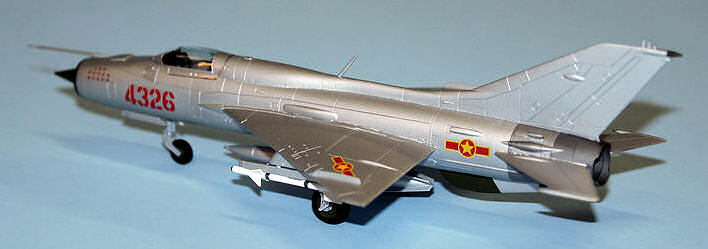
| KIT #: | 72026 |
| PRICE: | $25.00 when new |
| DECALS: | Four options |
| REVIEWER: | Kevin Thompson |
| NOTES: |

| HISTORY |
The Mikoyan MiG-21 is the most widely produced jet fighter of all time, and is the most-produced fighter aircraft since World War II, with more than 10,000 examples having been manufactured during a span of over four decades. This delta-winged Mach 2-capable interceptor has served with the air forces of over 50 nations, and is still a front-line aircraft in over half of those countries. Simple, rugged and cost-effective, it provided an effective short-range interceptor platform with excellent overall performance, and was constantly evolved in four generations of sub-types. Over time, the Cold War-era MiG-21 saw limited action in various conflicts around the world, but had its most intensive combat use in Southeast Asia, in the hands of the Vietnamese People’s Air Force (VPAF, North Vietnam) from 1965 to 1973.
The MiG-21PF was the first of the
“second generation” of this series of aircraft. The original first generation
MiG-21F (NATO code-name “Fishbed-C”) was basically a clear-weather,
point-defense interceptor, and was limited in its range, armament, and avionics.
The PF (for “Perekvatchik Forsirovannyi”, Russian for “all-weather
interceptor, boosted”) was fitted with an RP-21 Sapfir (Sapphire) Spin
Scan radar, giving it all-weather interception capability. This required
enlarging the forward fuselage and nose cone diameter. The fuel capacity was
increased in the upper fuselage area behind the cockpit. The PF featured several
other changes, including enlarged speed brakes, larger tires and wheels for
better rough field performance, a relocated VHF antenna, and a shorter air data
probe, moved to the top of the forward fuselage. Armament was two R-3S AAMs,
basically a copy of the American AIM-9 Sidewinder. The PF was a logical
successor to the F model, and all of the Warsaw-Pact air forces began receiving
the new plane in the early 1960s. NATO code-named the PF Fishbed-D.
behind the cockpit. The PF featured several
other changes, including enlarged speed brakes, larger tires and wheels for
better rough field performance, a relocated VHF antenna, and a shorter air data
probe, moved to the top of the forward fuselage. Armament was two R-3S AAMs,
basically a copy of the American AIM-9 Sidewinder. The PF was a logical
successor to the F model, and all of the Warsaw-Pact air forces began receiving
the new plane in the early 1960s. NATO code-named the PF Fishbed-D.
When communist North Vietnam began equipping their air force in 1964, they first received the subsonic MiG-17 from the USSR and later China. The following year the first MiG-21 deliveries arrived, and by early 1966 the VPAF had both the MiG-21F and PF in its inventory (about 50 aircraft, both types combined) alongside the venerable MiG-17. The first VPAF MiG-21s served with the 921st Fighter Regiment, based at Noi Bai airfield near Hanoi. The VPAF now had a modern interceptor that could take the fight to the attacking US fighter-bombers such as the F-4, F-8, and F-105. Pilot Nguyen Hong Nhi scored the VPAF’s first “kill” in a MiG-21 when he shot down a Firebee drone on March 4, 1966. By the end of the year, the VPAF had downed twenty US aircraft (including F-4 Phantoms and F-105 Thunderchiefs) with their MiG-21s. In 1967, VPAF MiG-21 pilots downed 36 US aircraft. During 1968 and 1969 a further 19 were claimed, bringing the total to 75 US aircraft downed by 921st MiG-21s.
By 1970, a few mediocre
black-and-white photos of VPAF MiG-21s found their way into some western
aviation magazines. Up to that time, the US had very little information on the
VPAF, their pilots or planes. Other than gun camera footage shot by USAF and US
Navy aircraft during their MiG-17 and MiG-21 “kills”, there was not much else to
go on. At least two of these published photos out of North Vietnam showed a
MiG-21PF (number 4326) parked in what appeared to be a public display area. The
nose of this MiG-21 was clearly decorated with thirteen “kill” stars, and this
spawned a great deal of speculation in the US. Did the VPAF have a really
skilled “ace” with 13 kills? If so, who was he? Soon thereafter, rumors began to
circulate of a “Colonel Tomb” who was, as one US publication claimed, the
“top-scoring ace of the North Vietnamese air force”. This name, also seen in
print as “Toon” and 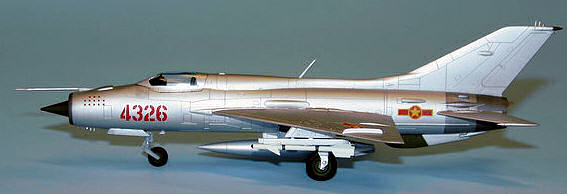 “Ton”, turned out to be a completely fictional and mythical
character; a product of fabrication that never really existed. Navy aces Randy
Cunningham and Willy Driscoll even claimed him as their third MiG-17 kill while
flying an F-4 on May 10, 1972!
“Ton”, turned out to be a completely fictional and mythical
character; a product of fabrication that never really existed. Navy aces Randy
Cunningham and Willy Driscoll even claimed him as their third MiG-17 kill while
flying an F-4 on May 10, 1972!
In 2001, the Osprey book “MiG-21 Units of the Vietnam War” by Istvan Toperczer was published. Dr. Toperczer, a flight surgeon with the Hungarian Air Force, has done an extensive research on the VPAF, and was allowed access to VPAF records through the Vietnamese embassy in Budapest, and trips to Hanoi which included interviews with several of the VPAF’s surviving MiG pilots. This book is the definitive work on the subject, and clears up several of the myths surrounding this 30-plus year old history.
By late 1969, the leading ace of the VPAF was Nguyen Van Coc, who had claimed 9 kills, including four F-105s, two F-4s, two Firebees, and one F-102. VPAF pilots flew several different aircraft, and didn’t have a “personal” plane. By the same token, this meant that a single aircraft would end up being flown by several different pilots. VPAF records show that Nguyen Van Coc flew this MiG-12PF (number 4326) on May 7, 1968 when he shot down F-4B BuNo 151485 of VF-92, launched from the USS Enterprise. This was his seventh kill. Being that the 921st had claimed 75 US aircraft up to that time, it is not out of the question that this particular aircraft was in fact decorated with the victories of a handful of pilots up to that time. Another 921st PF (number 4324) had fourteen kill stars on its nose, although western aviation journalists did not know of this decorated MiG until many years later. By the end of US involvement in Vietnam in early 1973, the VPAF MiG-21 pilots had claimed a total of 133 US aircraft destroyed, and thirteen pilots had earned ace status. The VPAF MiG-21 deliveries expanded to over 200 aircraft, and included the F, PF, PFM, MF and bis variants. A second MiG-21 unit was formed, the 927th Fighter Regiment. Over 95% of the US aircraft losses over North Vietnam were as a result of an intensified air defense system that included the SA-2 “Guideline” surface-to-air missile, and heavily-concentrated AAA installations. Of a total of 4181 US aircraft claimed shot down over North Vietnam, the VPAF fighters accounted for about 5% of this, and the MiG-21 earned roughly two-thirds of this figure, being nearly twice as successful as its subsonic older brother, the MiG-17. This historic actual aircraft, 4326, is currently restored and on display at the Vietnamese People’s Air Defense Museum in Hanoi.
| THE KIT |
Fujimi’s excellent series of 1/72
MiG-21s came out around 1991, and although quite pricey at $25.00 each, proved
to be the definitive kits of this Soviet fighter. They did several versions,
including the PF (both early and late), the MF, bis, and “R”
reconnaissance versions. They all offered a choice of three or four different
markings for each kit, giving the modeler a wide
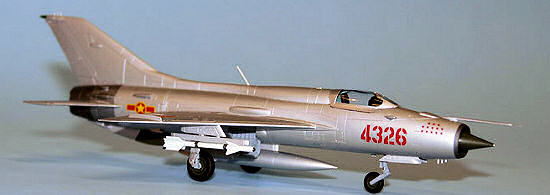 variation of nations and
colors. We will cover the early PF “Phantom Killer” kit, number H-26. This kit
features the early, narrow-chord fin with no braking-chute pod.
variation of nations and
colors. We will cover the early PF “Phantom Killer” kit, number H-26. This kit
features the early, narrow-chord fin with no braking-chute pod.
This version of the MiG-21 series is my favorite aesthetically, before the upper fuselage and tail fin got too “chunky” on the later versions. Kit is a gem; 70-plus beautifully molded parts with recessed panel lines, minimal flash, excellent overall shape and thickness, and a great fit. The ailerons and flaps are separate individual pieces from the wings, giving the builder optional positions. As close to “perfect” as this kit is, there is one slight inaccuracy, and it is so minute that I did not bother correcting it on my build. It is the taper on the horizontal stabilizers in planform. The leading edges are OK as far as sweep angle, but the trailing edges should be just a few more degrees swept, and this would give a slight increase in the chord at the tip. As I said, it is minor, but is detectable by a careful eye. Other than that, all the plastic looks good, and it looks as if it will be, once built, a definitive representation of the most famous Soviet jet of all time.
One other point to mention is the decal sheet. Fujimi has historically never had the best decal sheets, and this one is no exception. Markings include North Vietnamese “Phantom Killers” 4324 and 4326, as well as Hungarian and East German markings. Numbers on decal sheet are too large for model, are too pale in printed color, and North Vietnamese insignia has metallic gold star instead of yellow, and this is just plain wrong. I will use other decals for this model. If the decals and a tiny discrepancy in the horizontal stabs are all there is to complain about, we’re good to go. Kit is still a “99.9 out of 100” in my book.
| CONSTRUCTION |
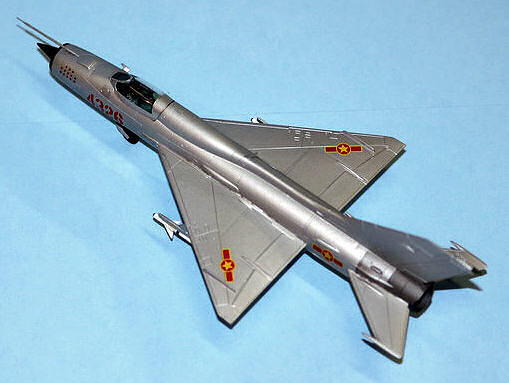 Started out with the cockpit, which
consists of the tub, stick, instrument panel and ejection seat, with separate
headrest and head protection blade (a flap which helps protect the pilot’s head
during an emergency ejection). The tub, seat and instrument panel was painted
Model Master II interior blue/green 2135, which is a dedicated color for Soviet
aircraft cockpits. Seat cushion and details were done in khaki, olive drab and
medium gray where applicable. Squadron Signal’s “MiG-21 Fishbed
Walk Around” by Hans-Heiri Stapfer (number 37) is an excellent guide for
detail colors. There are three decals for instrument faces and left and right
console switches that work well, but require a little Micro Sol to settle down
over the console bumps. After the cockpit painting and decals were complete, I
applied Dullcote over the whole assembly. Kit even features a four-piece pilot
figure, but I left him out, as I do with most kits, unless it’s going to be in a
diorama.
Started out with the cockpit, which
consists of the tub, stick, instrument panel and ejection seat, with separate
headrest and head protection blade (a flap which helps protect the pilot’s head
during an emergency ejection). The tub, seat and instrument panel was painted
Model Master II interior blue/green 2135, which is a dedicated color for Soviet
aircraft cockpits. Seat cushion and details were done in khaki, olive drab and
medium gray where applicable. Squadron Signal’s “MiG-21 Fishbed
Walk Around” by Hans-Heiri Stapfer (number 37) is an excellent guide for
detail colors. There are three decals for instrument faces and left and right
console switches that work well, but require a little Micro Sol to settle down
over the console bumps. After the cockpit painting and decals were complete, I
applied Dullcote over the whole assembly. Kit even features a four-piece pilot
figure, but I left him out, as I do with most kits, unless it’s going to be in a
diorama.
Next step was rear exhaust afterburner assembly, which was painted in Testors exhaust metalizer, and put in the right fuselage half. I then put the appropriate amount of weight in the nose (used tape-on lead wheel weights, which can be cut down to any size, and have an adhesive surface on the back). I always secure the weights with CA glue, remembering some of the kits I did as a kid that eventually had a “variable cg” or loose ballast! After the weight was installed, the nose cone was also cemented to the right fuselage half, as was the nose gear bay. From here on it was straightforward airframe assembly. Married the fuselage halves together, then applied upper fairing (spine hump) and vertical fin.
Next step was the wings. Although the kit has separate ailerons and flaps, just about every photo I’ve ever seen of a MiG-21 parked has all the controls locked in the neutral position. Therefore, I decided to glue the flaps and ailerons as such, and these parts are really an outstanding fit in the wings: no gaps or anything. When done, each wing looks as if it was one piece, not four! Everything on this kit fits well, and the wings and tail feathers are no exception. Once the airframe was complete, I let it dry overnight for sanding the next day. Just a light amount of dry, then wet sanding with 400 then 1000 was all that was needed to fill the seams. No filler was used.
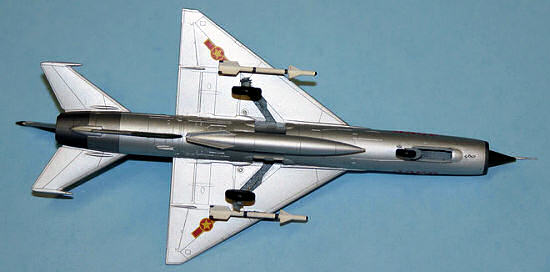 Once the fuselage was smooth, all
the delicate pieces were installed, including ventral fin, missile racks,
centerline tank pylon, afterburner cooling ducts, VHF antenna, main and nose
gear doors, and a few other small bits. I’ve found that installing as much of
the small stuff before painting creates stronger joints for these bits, and
minimizes risk of damaging painted surfaces after the fact. I did not yet
install the centerline tank, but assembled the two halves and smoothed it out in
the same fashion as the fuselage. Once I was ready to paint the airframe, I
scanned it over and found that there was one important feature missing. Mig-21s
are fitted with SRO-2 Khrom IFF antenna which has three little poles on
the rear of the vertical stabilizer, and underneath, just ahead of the nose gear
doors. Most MiG-21 kits have these little spikes, but curiously, Fujimi did not
include them, even though they covered everything else very well. I took
some scrap sprue, stretched it over a flame, cut it into lengths (six little
pieces), and glued them on in the appropriate locations. Now it looks like a
MiG-21and is ready for paint!
Once the fuselage was smooth, all
the delicate pieces were installed, including ventral fin, missile racks,
centerline tank pylon, afterburner cooling ducts, VHF antenna, main and nose
gear doors, and a few other small bits. I’ve found that installing as much of
the small stuff before painting creates stronger joints for these bits, and
minimizes risk of damaging painted surfaces after the fact. I did not yet
install the centerline tank, but assembled the two halves and smoothed it out in
the same fashion as the fuselage. Once I was ready to paint the airframe, I
scanned it over and found that there was one important feature missing. Mig-21s
are fitted with SRO-2 Khrom IFF antenna which has three little poles on
the rear of the vertical stabilizer, and underneath, just ahead of the nose gear
doors. Most MiG-21 kits have these little spikes, but curiously, Fujimi did not
include them, even though they covered everything else very well. I took
some scrap sprue, stretched it over a flame, cut it into lengths (six little
pieces), and glued them on in the appropriate locations. Now it looks like a
MiG-21and is ready for paint!
| COLORS & MARKINGS |
All of the MiG-21F-13s and MiG-21PFs
in service with the VPAF were natural metal. Camouflage came along a couple of
years later on just a few of the PFM versions (I will be doing a review of the
Zvezda PFM kit down the road). Vietnam’s harsh tropical climate of heat and
humidity meant that these aircraft were pretty dull in finish. Before I applied
the natural metal finish, I painted the nose cone and forward area of the
ventral fin in a color I refer to as “MiG green” (a mixture of Model Master
FS34079 and 34102 flat greens). After they dried, I masked them off and painted
the nose ring and exhaust area in a couple of dark metalizers. Note the
 difference in the two shades of metal at the exhaust and rear fuselage area
between the vertical and horizontal stabilizers. I then applied some metalizer
sealer to them, and once dry, masked them off. As stated earlier, Vietnamese
MiGs were rough duty machines, and to do the aluminum finish on this model, it
was very simple: Model Master aluminum non-buffing metalizer. Once the several
coats of metalizer were dry, I applied one coat of metalizer sealer. This
actually gives a slight sheen, but was for decal adhesion and protection from
fingerprints while handling, and is not the final finish.
difference in the two shades of metal at the exhaust and rear fuselage area
between the vertical and horizontal stabilizers. I then applied some metalizer
sealer to them, and once dry, masked them off. As stated earlier, Vietnamese
MiGs were rough duty machines, and to do the aluminum finish on this model, it
was very simple: Model Master aluminum non-buffing metalizer. Once the several
coats of metalizer were dry, I applied one coat of metalizer sealer. This
actually gives a slight sheen, but was for decal adhesion and protection from
fingerprints while handling, and is not the final finish.
Markings are simple; VPAF insignia in six positions, tactical number 4326 on both forward fuselage sides, and thirteen kill stars ahead and above the tactical numbers. Since I am picky with markings for the most part, and no kit or aftermarket sheet had done these accurately, I called upon Mark Borer to make the appropriate size insignia and numbers on his ALPS printer. He did a great job, and at my request, Mark also scaled these up to 1/48 and 1/32 for future projects. Once the decals were applied, another coat of metalizer sealer was applied. To make the whole aluminum finish dull, as the real planes were, I then applied two light coats of Dullcote lacquer. Nothing high-tech here; just a dull silver airplane! I kept the Dullcote off the nose cone, as these appear in photos to have been semi-gloss. With the main finish complete, it was now time to finish off the kit with the landing gear, missiles, canopy and the rest.
| FINAL CONSTRUCTION |
Before the landing gear went on, the
gear legs, wheel wells and gear bays were all painted Model Master FS 36375
light ghost gray, which is the correct gray for MiG-21 gear internals. This can
clearly be seen in the color photos of the Squadron “Walk Around” book. Wheels
and hubs are the “MiG green” I mentioned earlier, with the tires in good ol’
flat black. After the gear legs and
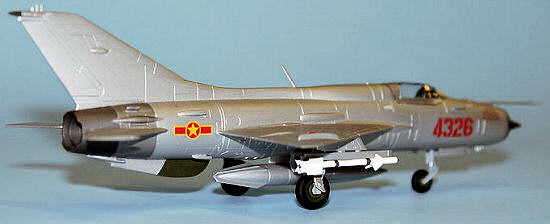 hydraulic actuator struts were installed
using CA glue, they were touched up in gray and chrome silver. I then installed
the centerline drop tank. The centerline tank was painted in the same manner as
the airframe to be dull aluminum. The “Atoll” air-to-air missiles were painted
flat white, with dark (almost black) metalizer stripes and tail fin tips. These
were then glued on to the pylons. Next was the canopy and gun sight. Canopy was
masked and sprayed in aluminum but not dull coated, as some photos reveal a
slightly different sheen between canopy framing and main fuselage. Gun sight is
small elliptical transparency, but once installed, looks better painted gloss
black. The canopy was then glued on with Elmer’s white glue. The last thing was
the forward air data probe; that long “spear” that all MiG-21s have. Once
painted in aluminum, it was installed atop the forward fuselage. The final touch
was to put a dab of chrome silver on the very tip of the nose cone. Like an
SR-71, these inlet spikes have natural metal at the very tip. The model is now
complete.
hydraulic actuator struts were installed
using CA glue, they were touched up in gray and chrome silver. I then installed
the centerline drop tank. The centerline tank was painted in the same manner as
the airframe to be dull aluminum. The “Atoll” air-to-air missiles were painted
flat white, with dark (almost black) metalizer stripes and tail fin tips. These
were then glued on to the pylons. Next was the canopy and gun sight. Canopy was
masked and sprayed in aluminum but not dull coated, as some photos reveal a
slightly different sheen between canopy framing and main fuselage. Gun sight is
small elliptical transparency, but once installed, looks better painted gloss
black. The canopy was then glued on with Elmer’s white glue. The last thing was
the forward air data probe; that long “spear” that all MiG-21s have. Once
painted in aluminum, it was installed atop the forward fuselage. The final touch
was to put a dab of chrome silver on the very tip of the nose cone. Like an
SR-71, these inlet spikes have natural metal at the very tip. The model is now
complete.
| CONCLUSIONS |
I am very pleased with this kit, and the result. The MiG-21, like any other aircraft, has some very distinctive features that are not always well represented in kit form. Fujimi has faithfully captured the correct look of this famous fighter, and their series of MiG-21 kits are undoubtedly the best available in 1/72. There are some newer “21” kits, such as the Zvezda kit which in quality are very close, though, and I will be reviewing that one fairly soon. I found the Fujimi build most trouble-free and rewarding, as this kit goes together like a Tamiya or Hasegawa kit. The “21” is one of the most famous fighters of all time, and is well represented here. My parting shot here is one of puzzlement: Fujimi still offers most of their 1/72 MiG-21 series, but not this kit of the early PF. Must be a marketing thing. If you like the early PF, this is the one to have in 1/72, so it will be swap meets or collector’s shows to find one.
August 2006
| REFERENCES |
MiG-21 Units Of The Vietnam War by Istvan Toperczer, Osprey Combat Aircraft number 29. Copyright Osprey Publishing 2001.
MiG-21 Fishbed Walk Around by Hans-Heiri Stapfer, Walk Around number 37. Copyright Squadron Signal Publications 2004.
Koku-Fan The North Vietnam Forces In The S.E.A. War, Bunrin-Do Publishing, 1973.
Copyright ModelingMadness.com. All rights reserved. No reproduction in part or in whole without express permission from the editor.
If you would like your product reviewed fairly and fairly quickly, please contact the editor or see other details in the Note to Contributors.